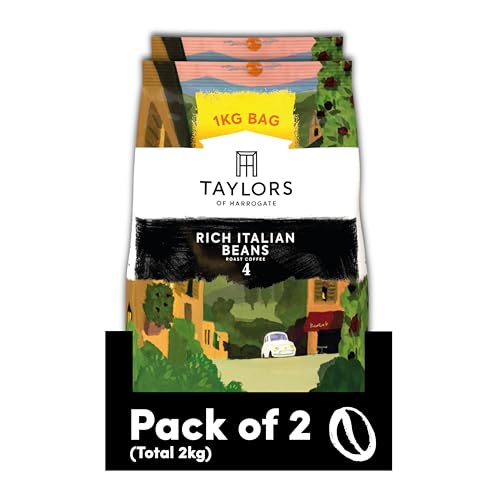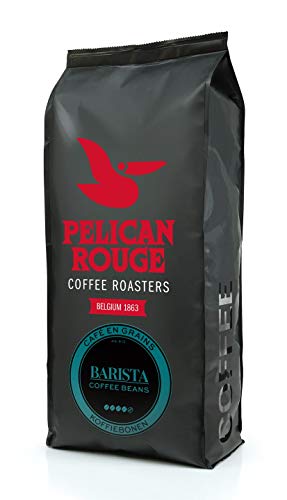9 Things Your Parents Teach You About 1 Kg Coffee Beans
페이지 정보
작성자 Patrick 작성일24-06-04 08:49 조회52회 댓글0건본문
 Why Buy Whole Coffee Beans in 1kg Bags?
Why Buy Whole Coffee Beans in 1kg Bags?A kilo of coffee beans will make around 142 single-serve cups. This is assuming that there isn't any spillage or waste.
A tablespoon of whole beans has about seven grams. If they are ground, a tablespoon can contain more or fewer grams. This is due to differences in density and size.
Cost
As more coffee drinkers recognize the value of making a delicious cup of joe at home, they are paying more attention to their coffee beans. Purchasing whole, fresh high-quality coffee beans in 1kg bags is a wise investment for your taste buds as well as your wallet. 1kg of beans can make 55 to 100 cups depending on the strength of your coffee.
The price of a kilogram of coffee beans is affected by a variety of factors including processing and transport costs. These fees, which may seem small at first glance however, quickly add up and have a significant impact on the cost of coffee beans. The cost of a kilo of coffee beans may also increase if there is an issue with roasting or in the event that it is not of a satisfactory quality.
Besides these expenses, there are other indirect expenses that coffee producers must consider when planning the budget for their harvests. These expenses include export taxes, the contribucion-cafetera tax charged by FNC, and port fees. Some importers charge management and administrative fees which can be astronomically high.
Another factor that affects the cost of a 1 Kg Coffee Beans of coffee beans is the much the Freshly Roasted 1kg Coffee Beans - Shop Now coffee sells for. The retail price of coffee beans is determined by the cost of green coffee and can differ greatly. The price of green coffee is also dependent on the region and country where it is produced.
You should also take into account the coffee waste that is generated during roasting or processing when calculating the cost per kilogram of beans. For instance, the coffee waste that is generated by the grinder's plates can decrease the weight of the beans. This allows for an accurate calculation of the number of servings that the kilogram of coffee beans produce.
The roasting method used is also important in determining the number of cups of coffee that one kilogram of beans can yield. A light roast imparts a sweet and delicate flavor while a dark roast has a more intense and fruity flavor. The amount of coffee that can be produced by a kilo coffee beans will also be contingent on the type of the method of brewing, such as filter or espresso.
Environment
The environment impacts the production of coffee beans and a myriad of environmental issues are connected with this beverage. Deforestation, water pollution, and soil erosion are some of the environmental issues. Some of the largest coffee companies have made efforts to reduce their environmental impact, but much work remains. This includes encouraging sustainable farming practices and providing financial support for initiatives to preserve the environment.
Numerous studies have looked into the effects of climate changes on the production of coffee. They have discovered that the climate has a significant impact on the quality and yield of coffee beans. The impact of climate changes on coffee production depends on the type of coffee and the farming techniques employed. For instance the beans grown by farmers that grow their plants in shade will have higher aroma, acidity, and typicity compared to those grown in the sun. Additionally the beans grown by farmers who employ Agroforestry techniques are generally characterized by more flavor, aroma, and acidity than those grown in monocultures.
Another issue is the excessive use of chemicals in the coffee industry. These chemicals are not only harmful to people but also pollute water. This is particularly true for non-organic coffee that makes use of synthetic pesticides and fertilizers. The chemicals that are used up can leak into the water and cause disruption to ecosystems. This can cause harm to humans as well as wildlife.
In addition to these issues, the high cost of producing coffee can cause it to be unaffordable for a lot of families. Additionally, the absence of reliable rainfall can affect the harvest. This is because the growing conditions for coffee are extremely specific and a lack rain can lead to an unsatisfactory crop.
Climate changes will have a significant impact on the suitability for land to produce coffee. According to the research an increase in the number of suitable land will be observed and an increase in the area that is not suitable in most of the major coffee-producing countries. This will cause conflicts between coffee production and nature conservation. This will also reduce the amount of ecosystem service that are provided by areas of coffee production like controlling or supporting services.
Experimentation
Coffee beans are a versatile food that can be consumed in a variety of ways. They are renowned for their bitterness, however they can be controlled with the right mix of ingredients. They can be used to make coffee or as a ingredient in baked products. You can also add them into desserts to give them texture and flavour. Coffee beans are an excellent source of antioxidants that can be used in many recipes that promote health.
The taste of coffee is different according to the region in which it is grown, and its specific characteristics are affected by climate elevation, elevation, and soil quality. The methods employed to prepare the beans could alter the flavor. For example, honey processed coffees tend to have a sweeter, fruitier taste than conventionally-processed coffees. These kinds of coffees are growing in popularity with consumers. They are often cheaper than traditional coffees. However they are also more difficult to produce and require a higher level of expertise from the farmer.
Besides caffeine, coffee has significant amounts of phenolic compounds that are powerful antioxidants. The chlorogenic acids are among the most significant phenolic compounds. They are created through esterification of quinic acid as well as one or more trans-cinnamic acids. It has been proven that coffee can reduce and limit oxidative damage and also reduce the production of inflammatory mediators.
Infusion is one of the most popular ways to prepare coffee. It is one of the most popular ways to prepare. There are a myriad of flavors you can try. They can range from traditional flavors like chocolate or cinnamon to more exotic ones like lemon, orange and ginger. Certain of these flavors are already present in the beans of coffee, while others require to be added during the roasting process.
You can play around with the flavor of coffee by brewing it in a variety of ways. You can experiment using a more coarse grind to get a stronger coffee or make it stronger by brewing it at a higher temperature. These tests can help you determine your preferred brewing style.
Another interesting experiment using coffee is to sprinkle grounds over the soil of a potted plant to examine how it affects the growth. Similar experiments have been conducted, and, in the majority of cases, the plants that received the ground coffee had a faster growth rate than those that didn't.
Taste
The flavor of coffee depends on the individual's taste. The best way to determine the most flavorful coffee is to experiment with different grind sizes, brewing methods, and even blending beans. You can do more experimentation when you purchase by the Kilo. This can result in a more satisfying experience. In the long term, it is more affordable, as buying in bulk can reduce the amount of packaging waste. The coffee grounds that are a by-product of your daily brew could be composted. The purchase of bulk quantities is a more environmentally friendly option.
If you are new to espresso, it's likely that you'll have to go through several 250g bags to figure out how you can get the extraction right. This isn't a rare scenario, and it's an essential part of the learning process. Purchasing by the kilo will give you enough beans to get you through this stage, and perhaps even to aid you in transferring to other methods of brewing after you've learned the basics.
You'll save money if you buy the kilo instead of smaller bags because the shipping and packaging costs are lower. By buying by the kilo, you also reduces your carbon footprint, since it requires less bags and uses fewer degassing valves and seal strips than purchasing just two or three 250g bags at a time. The smaller number of bags used can also reduce waste going into landfills.
Another advantage of buying by the kilo is that it permits you to experiment with different roasts and flavors and can be a satisfying experience for coffee lovers. Additionally, it is easy to find a roaster or supplier who offer discounts on larger purchases. You can also purchase online and have the beans delivered to your doorstep which is extremely convenient for busy people.
You can also select packages that include a tamper mat, which allows you to attain the precision and consistency needed to make a perfect espresso shot. The tamper is made from durable materials and high-quality materials. It features a slip-resistant surface that minimizes noise and ensures you're getting exact pressure on the beans.

댓글목록
등록된 댓글이 없습니다.

